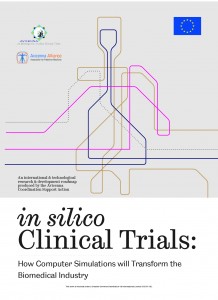The jumRoll Roadmap “in silico Clinical Trials: How Computer Simulation will Transform the Biomedical Industry”
The ultimate aim of the jumRoll action was to create a research and technological development Roadmap outlining a strategy for in silico Clinical Trials (ISCT). This Roadmap has now been approved by the European Commission. ISCTs are defined as the use of individualised computer simulation in the development and regulatory evaluation of a medicinal product, medical device, or medical intervention. Over 11 chapters, the Roadmap describes the route by which in silico techniques of computer simulation will be introduced into clinical trials, the studies that are routinely conducted to establish the safety and efficacy of new medical interventions.
Download the jumRoll Roadmap here
How was the Roadmap developed?
Over the two years of the project a series of 5 events were organised to develop the jumRoll roadmap using a consensus building process called Alignment Optimisation (AO), by SchellingPoint. This formal, software mechanism is used both to speed up the process of reaching consensus and to ensure alignment. Optimisation is brought about through the repeated operation of Future Mapping and Alignment Cycles, in which an identified process is rigorously executed in order to maximise the input from participants. The cycle progresses through a sequence that begins with confirmation that the group is correctly constituted and that the knowledge discovery process is appropriately taking place. The application of controlled methods ensures that the ensuing process of obtaining insights and moving to an effective resolution is performed efficiently, and the outputs are enshrined in a published charter of actions. Finally the tendency for such strategies to become eroded over time is limited by a change-monitoring system.
This action engaged 525 experts from 35 countries, including 22 of the 28 members of the European Union, in an 18 month consensus process. Experts were invited from the various relevant domains to help us by participating in discussions. This collaborative approach was designed to ensure that by summarising all the discussions and views gathered during the different events, the Roadmap represents a collegial vision, driven by the needs of industry and the wider society to investigate in detail the needs, the vision, the gaps, the impact and the research agenda of in silico clinical trials. jumRoll provided a chance for experts to broaden their horizons, and develop a collegial vision driven by the real needs of the industry – and of society at large – strong enough to impose a research funding allocation that is truly innovative, and that will give rise to a significantly positive socio-economic impact.
What does the Roadmap say?
This document provides an overview of how biomedical products are being developed today. Readers can find out where in silico clinical trials technologies are already being used, and how this area could extend in the future. From the identification of the barriers that prevent wider adoption, we derived a detailed list of research and technological challenges that require pre-competitive funding to be overcome.
The jumRoll Research and Technological Roadmap completes and concludes a decade of pioneering work around the Virtual Physiological Human (VPH). The document shows that the use of ISCT is already a tangible reality in industrial practice, albeit to only a limited degree. Furthermore, it is one of the most important strategic priorities in biomedical and technological research, if we are ever to make the development and the safety assessment of new biomedical products simpler, cheaper, faster, and safer, while at the same time minimising activities such as animal and human experimentation that increasingly pose ethical questions.
The Roadmap concludes with a series of recommendations to the community including stakeholders, academic and industrial experts, policy makers, funders, producers, and providers etc.
It suggests that the European Commission, and all other international and national research funding agencies support in silico clinical trial approaches, which could have huge socio-economic impact in the future. It also proposes that industrial and academic stakeholders explore the formation of a pre-competitive alliance to coordinate and implement public and privately funded research on this topic and that regulatory bodies across the world embrace innovation and, in collaboration with academic and industrial experts, develop the framework of standards, protocols and shared resources required to evaluate the safety and the efficacy of biomedical products using in silico clinical trials technologies (ISCT).
As the jumRoll consensus process demonstrated, in a globalised economy, the discourse on ISCT must be developed worldwide. Thus, all agencies should remove as many barriers as possible, and actively support pre-competitive research and technological development across countries and world regions.
The Roadmap proposes a challenge to the community: By 2025, cut the cost of bringing a new pharmaceutical to market from the current US$2.5bn to US$250m.
Roadmap citing
Please cite the Roadmap using the following:
Viceconti M, Henney A, Morley-Fletcher E. in silico Clinical Trials: How Computer Simulation will Transform the Biomedical Industry. Research and Technological Development Roadmap, jumRoll Consortium, Brussels Jan 2016. DOI: 10.13140/RG.2.1.2756.6164.


